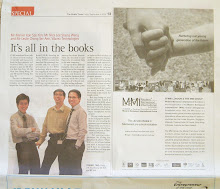
Contrary to some Fengshui Masters who use Chinese horoscope and geomancy to predict the behaviour of the stock market, the "calm" Rabbit year started the year rather turbulently. For the past two months, we have seen unrelated events, cascading to result in a mini crisis. In late January, there was a huge continuous selldown of Asian markets by large fund managers for 3 weeks. Before it ended, there was Middle East crisis heating up when Libya's unrest unwinding into a civil war. Crude oil prices shot past 2-year high and that caused great concerns to the recovery pace of the world economy. About when the oil prices eased a little with OPEC members' commitment to top up supply from Libya's shortfall, there was then a sudden Mother Nature's savage of a wrenching earthquake and treacherous tsunami that destroyed many parts of Japan, the 3rd largest world economy. All three unprecedented events sent the STI index to a double bottom of a 6-month low of 2921 points. I guess that's bad enough for many investors who got caught in a false confidence at the beginning of the new year when everything was painted all so rosy.
For those who held faith in the market, or who had capitalized on bargain hunting, the market always proves to be merciful. It did a spectacular recovery of more than 260 points in a short 3-week span. You would be helping your heart if you had hibernated out of the market for the last 3 months and opening to see your screen now, saving yourself the treacherous ride of the market; now that the STI has come close to last year's end closing of 3190 points. Phew! It was a 5-digit roller-coaster ticket price for me.
Now looking at the global economy, fundamentally is still unchanged. Broad-based economics still show an uptrend in a global recovery. US is still reporting improving sales and employment figures. The Dow Jones and S&P 500 indexes were showing continued uptrend which was momentarily disrupted by the recent crises. The US presidential election is slated to be held near the end of 2012. The government is not expected to do unfavourable measures to upset the market, especially when it is on its third year of running since the last election, as illustrated by previous election cycles. China is poised to contain its inflationary rate between 3-4% this year.
However, in a short to medium term view, there lies several risks which may hamper global economic growth and negative impact to the market.
For those who held faith in the market, or who had capitalized on bargain hunting, the market always proves to be merciful. It did a spectacular recovery of more than 260 points in a short 3-week span. You would be helping your heart if you had hibernated out of the market for the last 3 months and opening to see your screen now, saving yourself the treacherous ride of the market; now that the STI has come close to last year's end closing of 3190 points. Phew! It was a 5-digit roller-coaster ticket price for me.
Now looking at the global economy, fundamentally is still unchanged. Broad-based economics still show an uptrend in a global recovery. US is still reporting improving sales and employment figures. The Dow Jones and S&P 500 indexes were showing continued uptrend which was momentarily disrupted by the recent crises. The US presidential election is slated to be held near the end of 2012. The government is not expected to do unfavourable measures to upset the market, especially when it is on its third year of running since the last election, as illustrated by previous election cycles. China is poised to contain its inflationary rate between 3-4% this year.
However, in a short to medium term view, there lies several risks which may hamper global economic growth and negative impact to the market.
Japan, suffering from a triple whammy disaster, will spend the next few years rebuilding its nation. As a world supplier of many advanced technologies like microchip and automobile, related industries are going to feel the ripple effect from a serious shortfall of supply. The government has to sort out the urgent need of restoring power back to factories.
The Quantitative Easing 2 (QE2) fund injection of the US Fed is ending by mid of 2011. If there is no deterioration of the US economy, no fresh injection of funds would be expected further. Less hot money would be free flowing in and out of market. Furthermore, the Fed would start to increase the interest rates amid an improved economy. It would then be less attractive for fund managers to borrow from banks and invest into equities.
If crude oil price continues its relentless upward trend, it is certainly going to derail the recovery of the global economy.






